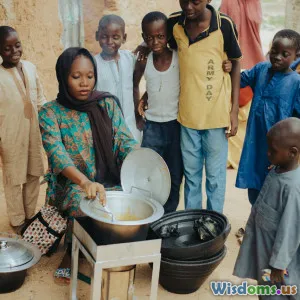
What Happens When Partners Grow At Different Rates
8 min read Explore the dynamics when partners experience unequal growth, its impact, and strategies for maintaining strong relationships through change. (0 Reviews)
What Happens When Partners Grow At Different Rates
Relationships are living, evolving entities, often mirroring the growth patterns of the individuals within them. But what happens when partners grow at different rates? Whether in emotional maturity, career success, personal interests, or life goals, divergent growth can challenge even the closest bonds.
In this extensive exploration, we'll unpack the consequences of unequal growth in partnerships, identify real-world signs and issues, and highlight methods to nurture understanding and resilience when growth paths diverge.
Understanding Growth in Relationships
Defining Growth in a Partnership
Growth within a partnership doesn’t just refer to the relationship itself but also to individual development. This includes aspects such as:
- Emotional intelligence and maturity
- Career and financial progression
- Personal values and belief systems
- Social circles and interests
- Life goals and priorities
Each partner may advance in these areas at different speeds or directions, triggering shifts that can be both enriching and challenging.
Why Growth Rates Differ
Growth is influenced by a mosaic of factors:
- Personal experiences: Trauma, education, or exposure to diverse perspectives can accelerate or delay growth.
- Support systems: Robust support can foster quicker development.
- Intrinsic motivation: Some individuals are naturally more driven toward self-improvement.
- Timing: Life circumstances such as parenting or career changes impact growth opportunities.
Understanding these nuances lays the groundwork to compassionately navigate differences.
The Impact of Different Growth Rates on Relationships
Differing growth rates can manifest in several poignant ways:
Communication Breakdowns
As partners evolve, their communication styles and emotional needs may change. For example, one partner developing higher emotional awareness might seek deeper conversations, while the other prefers surface-level exchanges. This mismatch can lead to frustration and withdrawal.
Shifting Power Dynamics
Growth often brings new skills, achievements, or confidence. When one partner ascends in career or personal efficacy, the balance of influence in decision-making or household responsibilities may tilt, sometimes causing resentment or insecurity.
Case Study:
A study in the Journal of Social and Personal Relationships (2020) revealed that career advancements by one partner without mutual support often correlate with increased relationship dissatisfaction by the less advanced partner.
Divergent Life Paths and Goals
Personal growth may lead individuals to reevaluate shared goals. For instance, if one partner embraces minimalist living to improve wellbeing but the other values material success, conflicts may arise over lifestyle choices.
Emotional Disconnect and Loneliness
When growth rates differ, partners can sometimes feel misunderstood or isolated. A partner expanding their social or intellectual horizons might crave experiences or conversations the other doesn’t share or appreciate.
Reduced Intimacy and Affection
As priorities and values shift, the couple’s emotional and physical intimacy may be affected. Studies suggest mismatched expectations on affection or connection correlate with increased conflict and decreased satisfaction (Hendriksen, 2019).
Recognizing the Signs of Divergent Growth
Early recognition can prevent fracture. Key signs include:
- Regular miscommunications escalating into conflict
- Decreased quality time due to differing interests
- Feelings of envy or inadequacy
- Unbalanced emotional labor or responsibility
- Avoidance of difficult or meaningful conversations
These signals call for action rather than neglect.
Navigating the Challenges: Practical Strategies
Open, Nonjudgmental Communication
Creating safe spaces for honest dialogue about each partner’s growth journey encourages empathy. Active listening without interruption or criticism fosters understanding.
Aligning Values and Goals Continuously
Partners should regularly revisit shared goals, adapting them to reflect new realities. For example, renaming "financial goals" in terms of shared visions helps harmonize efforts.
Embracing Individuality Within Togetherness
Acknowledging and celebrating different growth paths can enrich the relationship. Encouraging one another’s passions builds mutual respect. John Gottman, renowned relationship researcher, emphasizes the importance of honoring the partner's internal world to sustain connection.
Seeking External Support
Couples therapy or coaching provides tools to bridge growth gaps. Therapists help identify maladaptive patterns and teach strategies for alignment.
Building Patience and Flexibility
Growth is rarely linear. Flexibility helps partners accommodate changes without judgment or pressure.
Prioritizing Shared Experiences
Engaging in new hobbies or projects together can create common ground, slowing emotional drift.
Real-World Insights
Example: Entrepreneurial Couples
Entrepreneurs often experience rapid career shifts that may leave their partners behind in terms of lifestyle changes or stress management. Successful couples often establish communication rituals and clearly negotiated roles to balance divergent career growth.
Data Spotlight
According to a 2018 Pew Research Center study, 38% of couples reported that uneven income growth or career success led to tension, underscoring the tangible impact of growth disparities.
When Divergent Growth Leads to Breakdowns
In some cases, unequal growth can catalyze separation or divorce, especially if left unaddressed. An individual expanding self-awareness might realize the relationship inhibits fulfillment. Alternatively, frustration and misunderstandings may become irreparable.
However, awareness and proactive efforts often allow couples not only to survive but thrive despite differences.
Conclusion: Growth is Not a Race, But a Journey Together
Partners growing at different rates is a common experience fraught with challenges but also opportunities. Recognizing growth as a dynamic, personal process demands empathy, patience, and thoughtful communication. With conscious effort, couples can transform divergent growth into a foundation for deeper connection and mutual enrichment.
The key lies in valuing both individuality and partnership, forging a path where distinct journeys intertwine without conflict.
By embracing growth’s complex rhythms and offering unconditional support, couples can not only survive but nurture profound intimacy and shared meaning across life’s evolving stages.
References:
- Hendriksen, E. (2019). Emotional Intimacy and Relationship Satisfaction. Journal of Couple Therapy.
- Gottman, J. (2014). The Seven Principles for Making Marriage Work. New York: Three Rivers Press.
- Pew Research Center. (2018). Income and Influence in Marriage Dynamics.
- Journal of Social and Personal Relationships. (2020). Career Development and Relationship Quality.
Rate the Post
User Reviews
Other posts in Emotional Intelligence
Popular Posts















